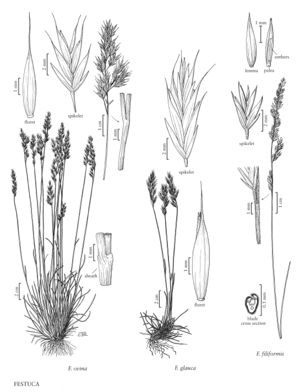Festuca glauca
Plants densely cespitose, without rhizomes; usually glaucous or pruinose. Culms (15)22-35(50) cm, erect, glabrous, smooth. Sheaths closed for about 1/2 their length, pubescent or glabrous, persistent; collars glabrous; ligules 0.1-0.4 mm; blades 0.6-1 mm in diameter, conduplicate, veins 5-7, ribs 1-3(5), indistinct; abaxial sclerenchyma forming continuous or interrupted bands; adaxial sclerenchyma absent. Inflorescences 2.5-9(11) cm, compact, erect, with 1-2 branches per node; branches stiff, erect, smooth or scabrous, lower branches with 2+ spikelets. Spikelets 5.5-9(11) mm, with 3-6(7) florets. Glumes exceeded by the upper florets, ovate-lanceolate to ovate, glabrous or pubescent distally; lower glumes (1.8)2-3(4) mm; upper glumes 2.8-4(5.1) mm; lemmas (3.5)4-6(6.2) mm, lanceolate to ovate-lanceolate, smooth or scabrous near the apices, sometimes pubescent distally, awns (0.6)1-1.5(2) mm, terminal; paleas about equal to the lemmas, intercostal region puberulent distally; anthers (1.8)2-3 mm; ovary apices glabrous. 2n = 42 [in European literature for the horticultural forms].
Discussion
Festuca glauca is widely grown as an ornamental in the Flora region because of its attractive dense tufts of glaucous foliage. It is not known to have escaped cultivation. Several other Eurasian species of fescue with white or bluish foliage are also sold in the horticultural trade as "Festuca glauca". Determining the species involved is beyond the scope of this treatment.
Selected References
None.
